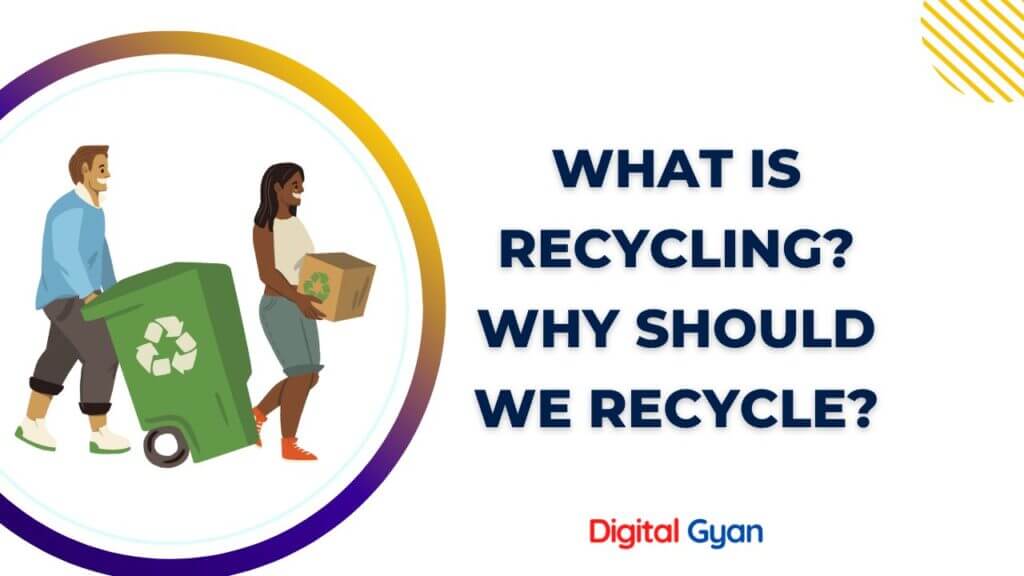What is Recycling? Why Should We Recycle Things?
The term “recycling” refers to transforming waste materials and goods into new ones for further utilisation.
It is fundamental to the concept of a circular economy, in which everything is used multiple times before being thrown away.
Recycling can be as basic as composting kitchen wastes or as complex as upcycling worn household items into something new, such as upcycling an old T-shirt into a wearable blanket. Even if we are unaware of it, recycling is a part of our daily life in whatever shape it takes.
We recycle because it’s important to our communities and the environment and because it’s part of our everyday routine. The majority of us recycle already, and the minority that doesn’t, would be wise to start.
Recycling is used in three main ways.

Utilizing recycled materials in the manufacturing of fresh goods
When a used item is collected, the materials can be recycled and put to use in making brand-new items. For instance, metal and plastic can be recycled into new goods like cans and bottles for food and drinks, while the non-metal components of plastic can be recycled into new plastic products.
Energy savings and carbon reductions can be considered when there is extensive recycling because the manufacturing process uses so much energy. The recycling procedure is also very effective because only the highest quality pieces are collected, and the most valuable components are reused.
In a circular economy, materials are recycled back into the manufacturing process after their useful life has ended. This boosts the circular economy and makes recycling more acceptable as a means of ‘getting green.
Benefits of Recycling
Recycling has a minimal impact on the natural environment. There is no damage to animals when fewer trees and forests are cut down. It helps protect ecosystems and species by reducing disturbances and damage to the natural environment.
Creating products from recycled materials is an effective way to save energy and preserve natural resources. The use of recycled steel, for example, can lower production energy consumption by up to 60%, while recycled newsprint can reduce it by 40%. Additionally, the use of recycled plastic can lower energy consumption by 70%, and recycled glass can reduce it by 40%. By using scrap metal instead of virgin ore to produce new steel, water usage can be decreased by 40%, and mining refuse can be reduced by 97%.
Recycling conserves nonrenewable materials. If we do not recycle paper, for instance, we will need to harvest 80 per cent more trees to satisfy the growing demand for paper. However, active paper recycling will reduce the amount of wood harvested by 20%. Recycling steel reduces air and water pollution by 86% and 75%, respectively, and eliminates 97% of the mining refuse generated by the production of new resources.
Recycling to increase the materials recycling rate
By recycling, the rates of materials collection and recycling increase. As the number of people recycling increases, more materials and items are recycled. This helps to reduce the amount of material being produced and sent to landfills or incinerators.
Top 6 Recycling Ideas
Recycling of Paper
Recycling paper is an easy and effective way to reduce our impact on the environment. By reusing paper, we can reduce the amount of waste that ends up in landfills, which helps to reduce greenhouse gas emissions. Additionally, recycling paper helps to preserve trees, which are essential for producing oxygen and maintaining healthy ecosystems.
When we recycle paper, it is collected and transported to a recycling facility where it is sorted and processed. The paper is then cleaned, de-inked, and turned into pulp, which can be used to create new paper products. By using recycled paper, we can reduce the amount of energy and resources needed to produce new paper, which helps to conserve natural resources and reduce pollution. In addition to creating new paper products, recycled paper can be used to create a variety of other useful items, such as gift wrap, paper bags, and cardboard boxes. By using these products instead of single-use items, we can reduce our overall impact on the environment.
Recycling aluminium cans
The material that is used to recycle aluminium cans is steel that is used in the manufacture of cans, aluminium that is used in the manufacture of cans, and the material that is used to make machines that are used in recycling.
Recycling plastic bottles
The materials that are used in the manufacture of plastic bottles are plastic, steel that is used in the manufacture of steel bottles, aluminium that is used in the manufacture of aluminium bottles, rubber that is used in the manufacture of rubber, and paper that is used in the manufacture of paper.
Recycling old furniture
The materials that are used in the manufacture of old furniture are wood, rubber, and plastic. If the material that is used in the manufacture of old furniture has been damaged, the material that can be used is still used in the manufacture of old furniture.
Recycling old appliances
The materials that are used in the manufacture of old appliances are metal, steel, rubber, and plastic. When the material is damaged, the damaged material that can be used in the manufacture of old appliances is still that used in the manufacture of old appliances.
Recycling electronic waste
The materials that are used in the manufacture of electronic waste are copper, aluminium, steel, and plastic. If the material that is used in the manufacture of electronic waste has been damaged, the damaged material that can be used in the manufacture of electronic waste is still used in the manufacture of electronic waste.
Also Read: Is Money Spent on Space Exploration A Waste?
Should Recycling be Made Mandatory?
There is no doubt that there is tremendous logic in reusing anything that is considered waste. Recycling is the most effective environmental conservation method. Recycling waste products not only reduce the disposal of waste into the environment but also reduces the consumption of new and fresh raw materials, which is crucial for energy conservation.
By mandating the recycling of goods, the dread of running out of resources will be mitigated by fifty per cent. Recycling will always combat various forms of pollution, such as air and water pollution, resulting in a cleaner environment. In other words, mandating recycling is tantamount to accepting a saviour for the environment, benefiting both current and future habitats. There is a strong connection between the recycling of used materials, energy conservation, the reduction of raw material extraction, and the difficulties caused by climate change.
If there are reasons to make recycling mandatory, then environmental compassion would be one of them. Certainly, recycling helps save trees. Everyone is aware of the significance of trees in the environment for sequestering carbon dioxide and enhancing respiration. Recycling used materials is the best method to protect the environment. Recycling benefits wildlife by conserving their habitat and promoting biodiversity by reducing the need to extract resources such as timber, mineral ores, and petroleum.

